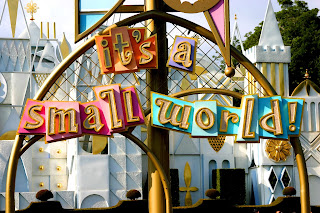Beginning with Umberto Eco's work, I particularly enjoyed the fascination he has towards the illusions and falsifications of establishments that incorporate blurred historic settings of the past, present, and future, presented into a live fantasy for visitors of all kinds, from all over the world, to partake in and enjoy. In the United States there exists not only outlets for amusement, but to an extravagant level of cities and city-like atmospheres and destinations that are created significantly for amusement itself. The city of Las Vegas does speak for itself, however, it is the purified fantasy and unbiased and blurred history of many theme parks and resorts that play with each individuals imagination, having them participate in a fantasy of there own that also seems to correlate with capitalism particularly well. Wax museums, and museums of art (no matter if they're reproductions) are a display of a certain time in history that realistically happened, but with an inability to create a fictionalized realism for viewers. In the "ghost towns", they create a hallucination that "serves to level the various historical periods and erase the distinction between historical reality and fantasy"; creating "confusion between copy and original". Disney Land not only utilizes the implications of history, fantasy, and imagination, but takes it and recreates a "more reality than nature can." It is a perfected falsification that visitors accept and admire. With Eco's physical perspectives of the use of illusion and fantasy, Ariel Dorfman and Armand Mattelart look at the psychological commercial exploitation of Disney and children literature.
"Disney is the great supranational bridge across which all human beings may communicate with each other." Through satirical explanation, they treat the "Disney message"as a conditioning of morality, that is constructed at an early age (childhood), and develops with the child until they are conscious adults, ready to repeat this seemingly father-complex cycle unto kin of their own. Here, they present to us the embodiment of a child within the author (adult), producing literature for the child to consume. "It enables the adult to partake of his own demons, provided they have been coated in the syrup of paradise, and that they travel there with the passport of innocence."
Disney's most famous feature is the attraction, "it's a small world!". It is the audio-animatronic children of the world's countries, the blurred historic turmoil, and a message that can alter the minds of millions of children, that may be an obvious example of play with hallucination, fantasy, and imagination.

No comments:
Post a Comment